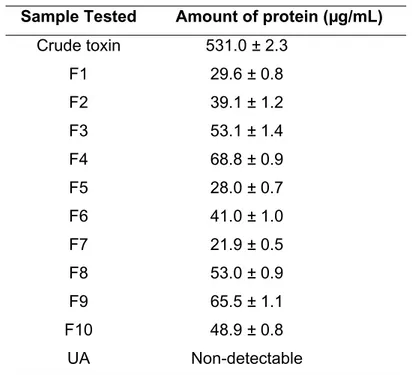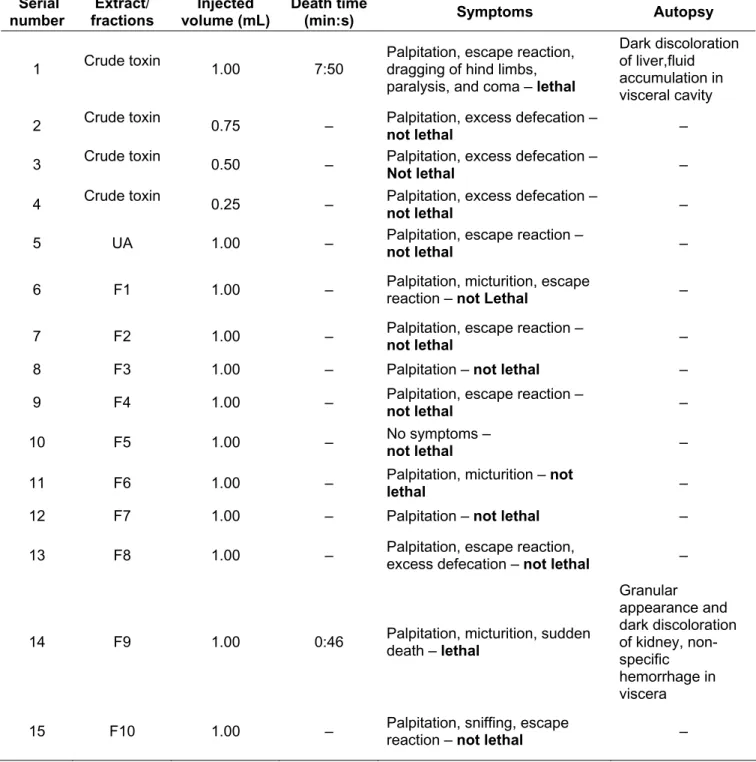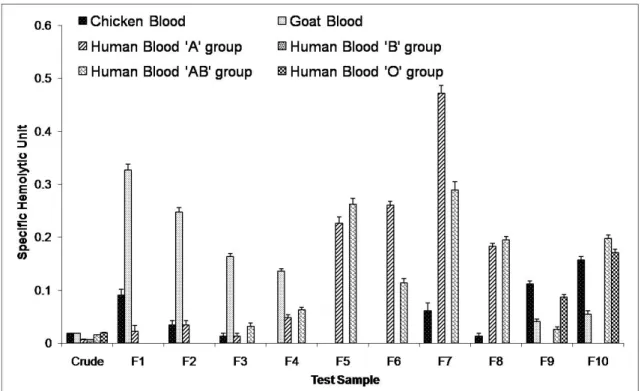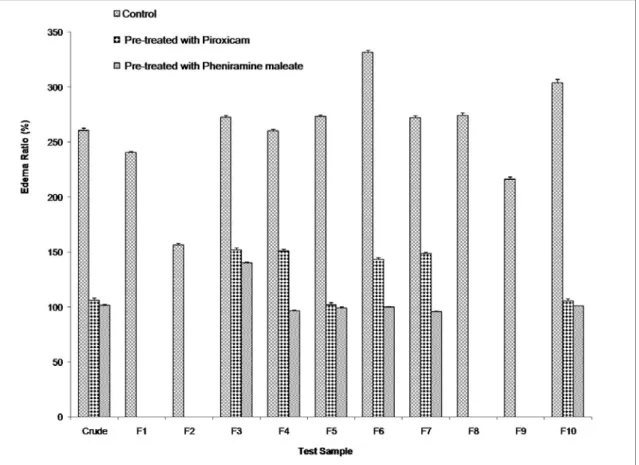Abstract published online: May 12, 2008
Full paper published online: August 31, 2008 ISSN 1678-9199.Original paper.
ON SOME TOXINOLOGICAL ASPECTS OF THE
STARFISHStellaster equestris (RETZIUS, 1805)
KANAGARAJAN U (1), BRAGADEESWARAN S (1), VENKATESHVARAN K (2)
(1) Centre of Advanced Study in Marine Biology, Parangipettai, Tamil Nadu, India; (2) Aquatic Biotoxinology Laboratory, Central Institute of Fisheries Education, Mumbai, Maharashtra, India.
ABSTRACT: Whole-body extracts in methanol were obtained from the starfish Stellaster equestris. The crude toxin was fractionated stepwise using diethylaminoethyl (DEAE) cellulose column chromatography. The crude toxin was lethal to male albino mice at a dose of 1.00 mL (containing 531.0 µg/mL protein) when injected intraperitoneally (IP) but the toxicity was abolished in all cases except one upon fractionation. The crude toxin and all the adsorbed fractions exhibited potent hemolytic activity on chicken, goat and human blood. However, group B human erythrocytes were resistant to lysis by all fractions and group O by most of the fractions. Paw edema in mice was caused by the crude toxin and all fractions. Pheniramine maleate and piroxicam blocked the toxicity when administered earlier than, or along with, the crude or fractionated toxins but not when administered after the envenomation. Pretreatment with either of these drugs also blocked edema formation.
KEY WORDS: starfish, toxicity, hemolysis, human blood groups, paw edema.
CONFLICTS OF INTEREST: There is no conflict.
FINANCIAL SOURCE: Tamil Nadu State Council of Science & Technology, Chennai,
India.
CORRESPONDENCE TO:
INTRODUCTION
The phylum Echinodermata includes a diverse group of typically slow-moving and non-aggressive marine animals, including three venomous classes, namely the Asteroidea (starfishes), Echinoidea (sea urchins), and Holothuroidea (sea cucumbers). The crown-of-thorns starfish, Acanthaster planci, being venomous, accounts for the majority of human envenomations (27) but poisonous starfish also affect health in countries including Taiwan where they are consumed (15, 42). A variety of toxins, which are comparable with the most toxic organophosphate chemical warfare agents (28), are reported from starfish; these include saponins (11), asterosaponins (sulfated steroidal glycosides) (40), free and sulfated sterols (17, 18, 19), and protein-like substances (39), besides tetrodotoxin (TTX) (20, 41) and paralytic shellfish poison (PSP) (2, 21). However, these toxins can also be used as guides leading to new, more effective therapies, because their targets of action are well known (9, 28). Despite the occurrence of around 350 species under 103 genera in Indian waters, echinoderms have been poorly studied in this country especially with reference to their toxicity and pharmacological potential. Hence, the present study focused on the biotoxinological aspects of the starfish Stellaster equestris from Cuddalore on the eastern seaboard of India.
MATERIALS AND METHODS
Specimen Collection
The starfish Stellaster equestris (Retzius, 1805) (Echinodermata: Asteroidea: Valvatida: Goniasteridae) was collected from the Fishing Harbor at Cuddalore (11q45’N, 79q47’E) and Mudasalodai Fish Landing Center at Parangipettai (11q32’N, 79q45’E), brought fresh to the laboratory (32 km and 2 km, respectively) and immediately air dried for subsequent use.
Preparation of Crude Toxin
1 (0.4 µm); it was then evaporated at low pressure using an R-200 Büchi Rotavapor® at 30qC. The resultant compound was stored at 4qC for further use as crude toxin.
Partial Purification Using Column Chromatography
The crude toxin was dissolved in phosphate buffer (pH 7.4) at 5 mg/mL and eluted through a DEAE cellulose column (height 32 cm; diameter 2 cm). Five unadsorbed fractions, 15 mL each, were eluted with phosphate buffer; and were later pooled and referred to as fraction UA. Ten adsorbed fractions, each 15 mL, were eluted with a step gradient of 0.1 to 1.0 M NaCl in phosphate buffer, and designated as fractions F1 to F10. All fractions were stored at 4qC for further use.
Protein Estimation
Crude protein content and partially purified fractions were estimated according to previous works (30) using bovine serum albumin (BSA) at the rate of 1 mg/1 mL as the standard.
Mice Bioassay for Lethality
All animal bioassays were carried out following the statement of the Institute Ethical Committee. The bioassay for lethality was done using clinically healthy male albino mice weighting 20 ± 2 g that were maintained in a healthy condition in the laboratory. Mice in triplicate sets were challenged intraperitoneally with 0.25, 0.50, 0.75 and 1.0 mL of the crude toxin, dissolved at 5 mg/mL in phosphate buffer saline (PBS); and with 1.0 mL each of the 11 fractions. A control was maintained in each case by injecting an equal volume of PBS (pH 7.4). The times of injection and death, besides behavioral changes before death, were recorded. Mice that died upon envenomation were autopsied to observe gross anatomical alterations.
Tests for Stability of the Crude Toxin
Tests were conducted in accord with previous works to assess the stability of the crude toxin upon (35):
x heating at 50qC, 60qC, 80qC and 100qC in a water bath for five minutes; x autoclaving at 120qC for 15 minutes;
x changing of pH (3.0 – 8.0); and
Hemolytic Activity
The crude toxin and the 11 fractions were assayed for their hemolytic activity on chicken, goat and human (A, B, AB and O) erythrocytes.
Samples of chicken and goat blood were obtained from a nearby slaughterhouse, while the human blood was obtained from Sheena Clinic, Andheri (W), Mumbai, using 2.7% ethylenediaminetetraacetic acid (EDTA) solution as an anticoagulant at 5% of the blood volume, and brought to the laboratory. The blood was centrifuged thrice at 5,000 rpm for five minutes; a 1% erythrocyte suspension was prepared by adding 99 mL normal saline to 1 mL of packed erythrocytes.
The microhemolytic test was performed in 96-well ‘v’ bottom microtitre plates. Serial two-fold dilutions of the crude toxin/fractions were made in 100 µL of normal saline. Then 100 µL of 1% erythrocyte was added to all the wells. For positive control, 100 µL of distilled water, and for negative control 100 µL of normal saline were added respectively to the 1% red blood cell (RBC) suspension. The plate was gently shaken and allowed to stand for two hours at room temperature. Presentation of uniform red-color suspension in the wells was considered to be positive hemolysis and a button formation in the bottom of the wells constituted a lack of hemolysis. The reciprocal of the highest dilution of the crude toxin showing the hemolytic pattern (hemolytic unit) was divided by the protein content to obtain the specific hemolytic unit.
Edema Formation
Following previous works (37), a group of two mice in each case was injected subplantarly with 0.1 µL of the crude toxin/fraction in the right footpad and with 0.1 mL of buffered saline in the left footpad. Two hours after injection, percentage of size increase was measured with a Vernier caliper and the growth of the envenomated paw relative to the saline-injected paw was taken as the edema ratio (ER). The minimum edematous dose was defined as the dose causing 105% ER.
Antidote Experiments
These two medications were selected since they are commonly used in India for the symptomatic relief of most envenomations in humans, though there are no recorded starfish poisonings or envenomations from this country. The antidote investigations were made using the crude toxin and those fractions which were lethal to mice. Control was maintained by injecting toxins (IP) at the previously determined lethal dose for each toxin but without any antidote. All experiments were carried out in triplicate sets.
The injectable solution was diluted further with PBS to obtain sufficient injectable volume for a dose as low as 0.2 mg. Three types of blocking experiments – pretreatment, cotreatment and post-treatment – were carried out:
x Pretreatment model: the test mice were injected IP with 0.9 mL (containing 0.2 mg of the active component) of pheniramine maleate/piroxicam, and set free in the cage. After 30 minutes, the animals were injected IP with the predetermined lethal dose, and kept under observation for 24 hours.
x Cotreatment model: 0.9 mL of pheniramine maleate/piroxicam and the predetermined lethal dose of the toxin were taken together in one syringe and injected IP to mice, which were then placed under observation for 24 hours. x Post-treatment model: the mice were first injected with the predetermined
lethal dose of the toxin. Immediately after the appearance of envenomation symptoms of, 0.9 mL of pheniramine maleate/piroxicam was administered IP to the mice, after which they were observed for 24 hours.
Edema Inhibition Tests
Only the pretreatment model was used in this case; 1 hour after IP administration of pheniramine maleate and piroxicam, at 0.2 mg/20 g body weight, the assay for paw edema was conducted as described above. Control experiments were performed on mice without the administration of drugs.
RESULTS
Crude Toxin
Protein Content of the Crude Toxin/Fractions (Table 1)
Protein content in the crude toxin was 531 µg/mL while the amount of protein in the purified fractions varied between 29 µg/mL (fractions F1, F5 and F7) and 68 µg/mL (fraction F4).
Table 1. Protein content of crude toxin, and its partially purified fractions, from the starfishStellaster equestris (all values are means of triplicate sets)
Sample Tested Amount of protein (µg/mL)
Crude toxin 531.0 ± 2.3
F1 29.6 ± 0.8
F2 39.1 ± 1.2
F3 53.1 ± 1.4
F4 68.8 ± 0.9
F5 28.0 ± 0.7
F6 41.0 ± 1.0
F7 21.9 ± 0.5
F8 53.0 ± 0.9
F9 65.5 ± 1.1
F10 48.9 ± 0.8
UA Non-detectable
Toxicity in Mice Models
Table 2. Toxicity of starfish crude toxin and its fractions (at 5.0 mg/mL) IP in male albino mice (20 ± 2 g)
Serial number Extract/ fractions Injected volume (mL) Death time
(min:s) Symptoms Autopsy
1 Crude toxin 1.00 7:50
Palpitation, escape reaction, dragging of hind limbs, paralysis, and coma – lethal
Dark discoloration of liver,fluid accumulation in visceral cavity
2 Crude toxin 0.75 – Palpitation, excess defecation –
not lethal –
3 Crude toxin 0.50 – Palpitation, excess defecation –
Not lethal –
4 Crude toxin 0.25 – Palpitation, excess defecation –
not lethal –
5 UA 1.00 – Palpitation, escape reaction –
not lethal –
6 F1 1.00 – Palpitation, micturition, escape reaction – not Lethal –
7 F2 1.00 – Palpitation, escape reaction –
not lethal –
8 F3 1.00 – Palpitation – not lethal –
9 F4 1.00 – Palpitation, escape reaction –
not lethal –
10 F5 1.00 – No symptoms –
not lethal –
11 F6 1.00 – Palpitation, micturition – not
lethal –
12 F7 1.00 – Palpitation – not lethal –
13 F8 1.00 – Palpitation, escape reaction, excess defecation – not lethal –
14 F9 1.00 0:46 Palpitation, micturition, sudden death – lethal
Granular appearance and dark discoloration of kidney, non-specific
hemorrhage in viscera
Stability Tests
Lethal activity of the crude extract was not affected after storage for 12 months at 20qC. The crude extracts were found to be thermolabile above 60qC. The crude toxin lost its activity in acidic pH; mice injected with it showed some symptoms of toxicity initially, but recovered within a few minutes.
Hemolytic Assay
The crude toxin as well as the fractions produced pronounced hemolytic activity on chicken, goat and human erythrocytes (Figure 1). Hemolytic factors were present in the crude toxin as well as in all the fractions except UA, but differed considerably depending on the type of blood used. Chicken blood, like groups A and AB of human blood, were the most vulnerable to lysis provoked by the starfish extracts. None of the fractions could lyse group B erythrocytes while group O erythrocytes were lysed by only two out of the ten fractions.
Antidote Investigation
Both the antidotes tested – pheniramine maleate and piroxicam – negated the toxicity of the crude toxin when injected prior to envenomation or together with the toxin. Injecting each the drugs after envenomation, could only delay the onset of death and were not sufficiently effective to prevent mortality.
Edema Formation
Mice paw edema was caused invariably by the crude toxin and all the fractions (Figure 2) with ER between 157 and 334%. Neither of the drugs tested could block the edematous activity of fractions F1, F2, F8, F9, and UA but was able to variably reduce the ER in all other cases, sometimes even below the stipulated 105%.
DISCUSSION
Methanol is considered as a universal solvent which could extract even the basic proteins without exempting any one of them; methanolic extracts of the whole body of the starfish Anthopleura fuscoviridis yielded two toxins AFT-I and AFT-II, that were lethal to mice (38). The protein levels observed during the present study compares well with previous results (36) that reported protein values as high as 4,820 mg/227 g of tissue from Acanthaster planci.
Our data further support the earlier findings that crude extracts of some echinoderms (4, 5, 24, 33, 43) and others extracted from spines of Acanthaster planci were lethal to mice (39). Sulfated saponins of echinoderms are toxic to fishes, annelids, arthropods etc. (10). The symptoms observed in envenomated mice in our study are indicative of central nervous system (CNS) toxicity and nephrotoxicity, concomitant with those reported for asterosaponins and saponins. Asterosaponins provoked paralysis in mice (34) while toxins of the British starfish, Marthasterias glacialis caused convulsions and drowsiness followed by collapse and death in mice (23). Our data suggest that the lethal element in the present crude toxin is different from those factors exhibiting hemolytic action, as had also been observed in the case of
Acanthaster planci (39).
Metabolites from echinoderms tend to cause cell lysis and hemolysis (29, 31, 32), as found in the present study. A partially purified product from the starfish Asterias
amurensis was hemolytic to rabbit red blood cells, toxic to killifish, lethal to fly maggots and earthworms, and emetic to cats (43). Five of the nine polar steroids isolated from the alcoholic extract of the Far Eastern starfish Henricia leviuscula showed moderate hemolytic activity in the mouse erythrocyte assay (16).
Similarly, it has been shown that the differential interaction of Escherichia coli, heat-labile toxin like cholera toxin with intestinal brush border glycoproteins of pigs (7) and rabbits (6) are dependent upon ABH and related blood group antigenic determinants. Our data assume significance and indicate that further in vitro studies are essential in order to clarity possible inter-individual (and possibly inter-regional/inter-racial) variability in susceptibility to the toxic effects of various plant and animal poisons and venoms.
Present results on the toxin stability corroborate those pertaining to A. planci (39); this toxin was non-dialyzable, and it lost its activity at 60qC or at pH lower than 3.0 or higher than 10.0. In addition the toxin that was exposed to repetitive freezing (at – 20qC) and thawing was inactivated. From these observations, it was considered that
A. planci toxin was probably a protein-like substance (39).
Similar instances of stability, as in the present study, have been encountered by other researchers (25). The presently extracted toxins are comparatively thermostable up to 60qC, possibly due to the tropical occurrence of the starfish from which they were extracted, as had been suggested in the case of cytolysin from
Radianthus sp (26). The phospholipase A2 component in starfish toxin is said to be
unstable at 40qC and has been reported to lose its activity completely when maintained for 25 minutes at 56qC (13). Susceptibility of the toxin to acidic pH observed is in accordance with earlier reports (22).
A number of thermolabile biotoxins of echinoderms are known to cause edema in experimental animal models and also in humans (37). Pretreatment and also cotreatment of both antihistaminic (pheniramine maleate) and antiprostaglandin analgesic (piroxicam) drugs have been effective in negating the toxicity of the crude toxin like that of the lethal fractions of the starfish species. However, on post-treatment, these compounds could only delay the onset of death, thus indicating that their use is limited only to symptomatic relief. Action of catfish mucus toxin was inhibited by pretreatment with atropine and indomethacin (1) while promoxine with hydrocorticosone, prednisone and 1% prednisone acetate with hyocine 0.25% were effective against nematocyst stings in humans (3).
pheniramine maleate, the antihistaminic drug, has either delayed or prevented death, indicating the involvement of histamine or histamine-like compounds in the toxins that caused death of test animals.
Between the two drugs tested, pheniramine maleate appears to be more effective than piroxicam in blocking both the lethal effect and edema formation.
ACKNOWLEDGEMENTS
Thanks are due to the Director, Center of Advanced Study in Marine Biology, Parangipettai, India and the Director, Central Institute of Fisheries Education, Mumbai, India for facilities provided. The first author thanks the Tamil Nadu Council of Science and Technology, Chennai, India for financial assistance.
REFERENCES
1 AL-HASSAN JM., THOMSON M., SUMMERS B., CRIDDLE RS., Purification and properties of a hemagglutination factor from the Arabian Gulf catfish (Arius
thalassinus) epidermal secretion. Comp. Biochem. Physiol., 1986, 85B, 31-9.
2 ASAKAWA M., NISHIMURA F., MIYAZAWA K., NOGUCHI, T. Occurrence of paralytic shellfish poison in the starfish, Asterias amurenis in Kure Bay, Hiroshima Prefecture, Japan. Toxicon, 1997, 35, 1081-7.
3 AUERBACH, PS. Clinical therapy of marine envenomation and poisoning. In: Tu AT (ed.) Handbook of Natural Toxins. Vol 3: Marine Toxins and Venoms. New York: Marcel Dekker, 1988, 493-565.
4 BAKUS GJ. Chemical defenses mechanisms and fish feeding behaviour on the Great Barrier Reef, Australia. Science, 1981, 211, 497-9.
5 BAKUS GJ., GREEN G. Toxicity in sponges and holothurians: a geographic pattern. Science, 1974, 185, 951-3.
6 BALANZINO LE., BARRA JL., GALVÁIN EM., ROTH GA., MONFERRAN CG. Interaction of cholera toxin and Escherichia coli heat-labile enterotoxin with glycoconjugates from rabbit intestinal brush border membranes: relationship with ABH blood group determinants. Mol. Cell. Biochem., 1999, 194, 53-62.
8 BRAEKMAN JC., DALOZE D., STOLLER C., VAN SOEST RWM. Chemotaxonomy ofAgelas(Porifera: Demospongiae). Bioch.l Syst. Ecol., 1992, 20, 417-31.
9 CATTERALL WA. Molecular properties of voltage-sensitive sodium channels.
Annu. Rev. Biochem., 1986, 55, 953- 85.
10 DHAWAN BN., GARG HS., GOEL AK., SRIMAL RC., SRIVASTAVA MN., BHAKUNI S. Bioactivity of marine organisms, part 7: screening of some marine fauna from the Indian coasts. Indian J. Exp. Biol., 1993, 31, 505-10.
11 FINDLAY JA., JASEJA M., BURNELL DJ., BRISSON JR. Major saponins from the starfish Asteria forbesi. Complete structures by nuclear magnetic resonance methods. Can. J. Chem. 1987, 65, 1384 -91.
12 GLASS RI., HOLMGREN J., HALEY CE., KHAN MR., SVENNERHOLM A., STOLL BJ., HOSSAIN KMB, BLACK RE, M. YUNUS M., BARUA D. Predisposition for cholera of individuals with O blood group: possible evolutionary significance. Am.
J. Epidemiol., 1985, 121, 791-6
13 GROTENDORST GR., HESSINGER DA. Enzymatic characterization of the major phospholipase A2 component of sea anemone (Aiptasia pallida) nematocyst venom.
Toxicon, 2000, 38, 931-43.
14 HARRIS JB., KHAN AI., LAROCQUE RC., DORER DJ., CHOWDHURY F., FARUQUE AS., SACK DA., RYAN ET., QADRI F., CALDERWOOD SB. Blood group, immunity, and risk of infection with Vibrio cholerae in an area of endemicity. Infect.
Immun., 2005, 73, 7422-7.
15 HWANG DF. Research on marine toxins in Taiwan. J. Toxicol. Toxin Rev., 2003, 22, 663-78.
16 IVANCHINA NV., KICHA AA., KALINOVSKY AI., DMITRENOK PS., DMITRENOK AS., CHAIKINA EL., STONIK VA., GAVAGNIN M., CIMINO G. Polar steroidal compounds from the far eastern starfish Henricia leviuscula. J. Nat. Prod., 2006, 69, 224-8.
17 IVANCHINA NV., KICHA AA., KALINOVSKY AI., DMITRENOK PS., STONIK VA., Hemolytic steroid disulfates from the far eastern starfish Pteraster pulvillus J. Nat.
Prod., 2003, 66, 298-301.
18 IVANCHINA NV., KICHA AA., KALINOVSKY AI., DMITRENOK PS., STONIK VA., RIGUERA R., JIMENEZ C. Hemolytic polar steroidal constituents of the starfish
19 KAPUSTINA II., PONOMARENKO LP., MOISEENKO OP., STONIK VA. Free and sulfated sterols of two far-east leptasterias starfish. Chem. Nat. Comp., 2001, 37, 515-9.
20 LIN SJ., HWANG DF. Possible source of tetrodotoxin in the starfish Astropecten
scoparius. Toxicon,2001, 39, 573-9.
21 LIN SJ., TSAI YH., LIN HP., HWANG DF. Paralytic toxins in Taiwanese starfish
Astropecten scoparius. Toxicon, 1998, 36, 799-803.
22 MACEK P., LEBEZ D. Isolation and characterization of three lethal and hemolytic toxins from the sea anemone Actinia equina L.Toxicon, 1988, 26, 441-51.
23 MACKIE AM., LASKER R., GRANT PT. Avoidance reactions of a mollusc
Buccinum undatum to saponin-like surface-active substances in extracts of starfish Asterias rubens and Marthasterias glacialis. Comp. Biochem. Physiol., 1968, 26, 415-28.
24 MACKIE AM., SINGH HT., FLETCHER TC. Studies on the cytolytic effects of seastar (Marthasterias glacialis) saponins and synthetic surfactants in the plaice
Pleuronectes platessa. Mar. Biol., 1975, 29, 307-14.
25 MAHNIR VM., KOZLOVSKAYA EP., KALINOVSKY AI. Sea anemone Radianthus
macrodactylus - a new source of palytoxin. Toxicon, 1992, 30, 1449-56.
26 MONASTYRNAYA MM., ZYKOVA TA., APALIKOVA OV., SHWETS TV., KOZLOVSKAYA EP. Biologically active polypeptides from the tropical sea anemone
Radianthus macrodactylus.Toxicon, 2002, 40, 1197-217.
27 MONICO EP., CALISE A., NOTTINGHAM D. Marine envenomations among home aquarium hobbyists. Internet J. Emer. Inten. Med. 2007, 10.
28 MUNRO NB., AMBROSE KR., WATSON AP. Toxicity of the organophosphate chemical warfare agents GA, GB and VX: Implications for public protection. Environ.
Health Perspect., 1994, 102, 18 - 37.
29 NAIK CG., KAMAT SY., PARAMESWARAN PS., DAS B., PATEL J., RAMANI P., BHAKUNI DS., GOEL AK., JAIN S., SRIMAL RC. Bioactivity of marine organisms. Part 5. Screening of some marine animals from the Indian coast. Mahasagar, 1989, 22, 99-104.
30 PETERSON GL. A simplification of the protein assay method of Lowry et al. which is more generally applicable. Anal. Biochem., 1977, 83, 346-56.
32 RAO DS., JAMES DB., GOPINATHAPILLAI CS., THOMAS PA., APPUKUTTAN KK., GIRIJAVALLABHAN KG., GOPINATHAN CP., MUTHUSWAMY S., NAMUDDIN M. Biotoxicity in Marine Organisms. In: Bioactive Compounds from Marine Organisms . Proceedings of an Indo – US Symposium (edited by Marg – Frances Thompson, R. Sarojini and R. Nagabhushanam), New Delhi: Oxford and IBH Publishing Co. Pvt. Ltd., 1991, 367-71.
33 RICKLEFS, RE. Ecology. 2.ed. New York: Chiron Press, 1979, 966p.
34 SANCHEZ J., BRUHN T., ANEIROS. A, WACHTER E., BERESS L. A Simple biochemical method in the search for bioactive polypeptides in a sea anemona (Anemonia sulcata).Toxicon, 1996, 34, 1361-6.
35 SHIOMI K., QIAN WH., LIN XY., SHIMAKURA K., NAGASHIMA Y., ISHIDA M. Novel polypeptide toxins with crab lethality from the sea anemone Anemonia
erythraea. Biochem. Biophys. Acta, 1997, 1335, 191-8.
36 SHIOMI K., YAMAMOTO S., YAMANAKA H., KIKUCHI T. Purification and characterization of a lethal factor in venom from the crown-of-thorns starfish (Acanthaster planci).Toxicon, 1988, 26, 1077-83.
37 SMITH M. Skin problems from marine echinoderms. Dermatologic Therapy, 2002, 15, 30-3.
38 SUNAHARA S., MURAMOTO K., TENMA K., KAMIYA H. Amino acid sequence of two sea anemone toxins from Anthopleura fuscoviridis.Toxicon, 1987, 25, 21-19. 39 TAIRA E., TANAHARA N., FUNATSU M. Studies on the toxin in the spines of starfish Acanthaster planci. I. Isolation and some properties of the toxin found in spines.Sci. Bull. Coll. Agri. Univ. Ryukyus, 1975, 22, 203-13.
40 TANG HF., YI YH., LI L., SUN P., ZHANG SQ., ZHAO YP. Three new asterosaponins from the starfish Culcita novaeguineae and their bioactivity. Planta
Med.2005, 71, 458-63.
41 TSAI YH., CHAO SM., LIN GT., NOGUCHI T., HWANG DF. Tetrodotoxins of the starfish Astropecten vappa collected from western Taiwan. Fisher. Sci., 2004, 70, 930-2.
42 US FOOD AND DRUG ADMINISTRATION. Foodborne Pathogenic Microorganisms and Natural Toxins Handbook. Tetrodotoxin. http://www.cfsan.fda.gov/~mow/chap39.html [Accessed 25 April 2006].



